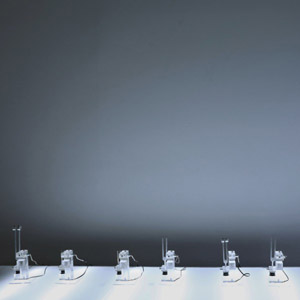 Utilizing the sound of tuning forks, a method of generating tones that goes back far into history, Nicolas Bernier places them in a motorized, computer controlled installation that belies the simplicity of its core. The single piece moves quickly, evolving from the simple resonating tones to a dense, complex synthesis of the naturally captured resonance and the computerized processing of the pure source material.
Utilizing the sound of tuning forks, a method of generating tones that goes back far into history, Nicolas Bernier places them in a motorized, computer controlled installation that belies the simplicity of its core. The single piece moves quickly, evolving from the simple resonating tones to a dense, complex synthesis of the naturally captured resonance and the computerized processing of the pure source material.
This approach to creating music is not a new one for Bernier, who has utilized numerous forms of archaic and unconventional sound generation tools (typewriters, malfunctioning machinery, etc.) but paired with modern technologies to create a hybrid of the old and new.The result sounds like neither time period specifically, but instead exists in some ambiguous area between the two.At the same time he juxtaposes composition and improvisation as well, with some moments of this long piece sounding rigidly structured by the machinery he created, and others feeling like knob twiddling at its finest.
The introductory moments of the piece stick mostly to the natural sound of tuning forks:each crystal clear chime is allowed to reverberate and resonate into silence, the space between the tones carrying just as much importance.The various tuned forks begin to overlap with one another, the fragmented sounds meld together, and with the added sine waves the complexity becomes astounding.
The digital manipulation is rather subtle at this point, mostly limited to looping and echoing pieces of the sound to extend it.As the processing and the machinery both speed up, the quick tones hitting in rapid succession it begins to resemble a large, digitally manipulated music box.Things begin to change once some extremely low end passages come in and offset the sharp metallic ringing sounds that have defined the composition up to this point.
At this point, about half way through, the organization of the piece seems to come apart, with shards of high end harshness cutting through and the ultra-sonic microtones make for what I assume is a perfect simulation of tinnitus.Everything here becomes a churning mass of noise that still resembles the standard sound of a tuning fork being struck at times, but only vaguely.The closing moments go back to a more stripped down approach, but now heavily bathed in the digital processing from before, ending in a realm of hushed, inorganic textures and near silent bits of noise.
I often find this type of academic sound art challenging to listen to too frequently, but that was not the case with Fragments.I was engaged throughout my first listen, and I gave it a second spin a relatively short time later.Bernier does such an impressive job at mixing the natural and the synthetic, and at times the work hints at the loose improvisation of harsh noise and the clinical precision of the minimalist of techno music without ever fully sounding like either one.That ambiguity, and the album’s fast pacing, make for an excellent work.
samples:
- Frequencies (a/Fragments) (Excerpt 1)
- Frequencies (a/Fragments) (Excerpt 2)
- Frequencies (a/Fragments) (Excerpt 3)
 
Read More

